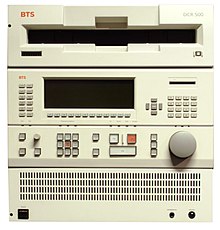D-1 standard
| D-1 standard | |
|---|---|
| Video standard | 4: 2: 2 component video |
| Digitization standard | ITU-R BT 601 |
| Data rate | 227Mbit / s |
| Information density | 4Mbit / cm² |
| Audio | 4 channels, 48 kHz, 16 bit |
| Width of the tape | 19 mm |
| Tape lengths | S-13min, M-41min, L-94min |
| Belt speed | 287 mm / s |
| Head drum speed | 150 revolutions / s |
The D-1 standard is the first worldwide standard for digital video recording on magnetic tape. It was agreed in 1985 by bodies of the Society of Motion Picture and Television Engineers (SMPTE) and the European Broadcasting Union (EBU) and published in February 1986. It belongs to the group of digital VTR systems without data reduction.
The system is designed for the transmission standards in the television environment of the time PAL or NTSC .
The 4: 2: 2 system according to the ITU-R BT 601 recommendation of the International Telecommunication Union is used to digitize the video data . Four digital audio channels can be recorded.
The digital video and audio data are recorded on the ¾ "tape in the form of oblique tracks 40 μm wide and 170 mm long at an angle of 5.4 °. Within a track, the data segments of the four audio channels are centered between At the edges there are also three analog longitudinal tracks, at the top with the audio cue information and at the bottom a control track and a track with the timecode .
The following sub-standards were defined:
- SMPTE 224M - track dimensions and positions of digital audio, video and additional data, as well as analog audio (cue track), time code (time code) and control track
- SMPTE 225M - specification of magnetic tape
- SMPTE 226M - Specification of the three cassette sizes S, M and L
- SMPTE 227M - Content, format and recording method of the digital data blocks in the helical tracks
- SMPTE 228M - Content, format and modulation methods of the analog longitudinal tracks
The first product to offer this standard on the market in 1987 was the Sony DVR-1000. A version with optimized weight, size and power consumption followed with the models DVR-2000 and DVR-2100. Another manufacturer was BTS Broadcast Television Systems GmbH with the BTS DCR 100, 300 and 500 models.
Individual evidence
- ↑ Johannes Webers: The technology of the audiovisual media. Volume 2, mitp, 2011, ISBN 978-3-8266-9135-5 , pp. 963-966.
- ^ A b Jeffrey B. Friedman: Digital television tape recording and other new developments; includes selected papers on television technology presented during the 20th Annual SMPTE Television Conference in Chicago, Ill., Feb. 7-8, 1986. ISBN 0-940690-12-8 .
- ↑ Summary Sony DVR-1000 manufacturer website from Sony. Retrieved May 13, 2018.
- ↑ Product data sheet Sony DVR-2100 website BroadcastStore.com. Retrieved May 13, 2018.
